Tuesday, September 19, 2006
Bartram's Garden/Bartram Village
 By design, this week’s trip was a little less thorough and intense. Having gone northeast to Bridesburg, it seemed like the thing to do was to balance things out and head southwest. Like most of Philadelphia’s regions, Southwest Philadelphia stretches far, far away from Center City down to the airport across the Schuylkill in the south. Unlike most regions in Philadelphia, you probably don’t know anyone who lives in Southwest Philly. Heavily industrial – albeit with some nice late 19th-century housing here and there – the southwest isn’t as famously frightening as some neighborhoods in North Philly, but a lot of it still seems pretty rough.
By design, this week’s trip was a little less thorough and intense. Having gone northeast to Bridesburg, it seemed like the thing to do was to balance things out and head southwest. Like most of Philadelphia’s regions, Southwest Philadelphia stretches far, far away from Center City down to the airport across the Schuylkill in the south. Unlike most regions in Philadelphia, you probably don’t know anyone who lives in Southwest Philly. Heavily industrial – albeit with some nice late 19th-century housing here and there – the southwest isn’t as famously frightening as some neighborhoods in North Philly, but a lot of it still seems pretty rough.
The neighborhood I picked could be viewed as wussing out a little bit; I went to Bartram’s Village, the neighborhood that includes Bartram’s Garden on one side of the train tracks and the Bartram Village public housing development on the other side. So instead of plunging directly into a neighborhood and its people, I wandered around an attractive Revolutionary-period estate for half the time, then popped into the housing development and took a couple handfuls of pictures. Unlike the last trip to Bridesburg, I didn’t really talk to anyone, didn’t soak in much the neighborhood atmosphere. Can you tell I feel a little guilty about this?
Village, the neighborhood that includes Bartram’s Garden on one side of the train tracks and the Bartram Village public housing development on the other side. So instead of plunging directly into a neighborhood and its people, I wandered around an attractive Revolutionary-period estate for half the time, then popped into the housing development and took a couple handfuls of pictures. Unlike the last trip to Bridesburg, I didn’t really talk to anyone, didn’t soak in much the neighborhood atmosphere. Can you tell I feel a little guilty about this?
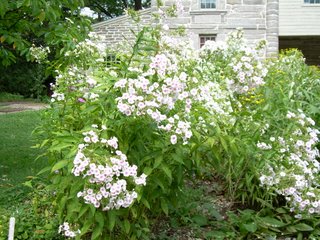 Anyhow, once I put my problems of perspective out of mind, I can say honestly that Bartram’s Garden is one of the city’s unappreciated oases. (Yeah, that’s the plural of “oasis.” I am a Grammar Jedi.) The Garden is the estate of the pre-Revolutionary gentleman and horticulturalist John Bartram, who founded the estate in 1728 and built the great house – with carvings done by the man himself – in 1731. A number of trails amble through the garden and the surrounding woods and meadows, and evidently some good botanical history is in practice here – the garden is an attempt at recreating the original 18th-century layout.
Anyhow, once I put my problems of perspective out of mind, I can say honestly that Bartram’s Garden is one of the city’s unappreciated oases. (Yeah, that’s the plural of “oasis.” I am a Grammar Jedi.) The Garden is the estate of the pre-Revolutionary gentleman and horticulturalist John Bartram, who founded the estate in 1728 and built the great house – with carvings done by the man himself – in 1731. A number of trails amble through the garden and the surrounding woods and meadows, and evidently some good botanical history is in practice here – the garden is an attempt at recreating the original 18th-century layout.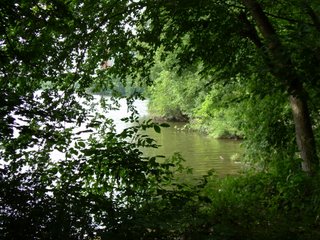
A little boardwalk weaves down to the Schuylkill, and views through the trees afford views of the river – both pastoral, otherworldly nature scenes and nasty industrial panoramas. A small alcove choked up with garbage is a pretty strong reminder: don’t put your crap in storm drains, ‘cause it’ll just end up downriver. (I am not usually of the tsk-tsk-environmentalist bent. But my girlfriend embraces tsk-tsk environmentalism wholeheartedly, and made me write that last bit. So there you have it.)
Heading over to the nearby meadow, I caught sight of what appeared to be a Muslim picnic. I don’t know how to put this in a politically correct fashion, so let’s lay it out: I have a sweet spot for sassy women in chadors. I was taking some pictures of the sea of little balls covering the  nearby hill, when I heard somebody yell “Hey! Excuse me, sir!” A group of about 15 Muslim women were looking at me – I had NO idea which one was yelling at me, so I tried to spread my eye contact around, and assured them that no, I wasn’t taking pictures of their kids who were playing nearby. “Good thing!” one of them snorted, “Otherwise we gonna make you buy something.” She pointed at a moveable rack full of traditional clothing, evidently for sale. As awesome as I’d probably look in a full-length tunic, I laughed and waved goodbye. “Have a nice day,” someone said.
nearby hill, when I heard somebody yell “Hey! Excuse me, sir!” A group of about 15 Muslim women were looking at me – I had NO idea which one was yelling at me, so I tried to spread my eye contact around, and assured them that no, I wasn’t taking pictures of their kids who were playing nearby. “Good thing!” one of them snorted, “Otherwise we gonna make you buy something.” She pointed at a moveable rack full of traditional clothing, evidently for sale. As awesome as I’d probably look in a full-length tunic, I laughed and waved goodbye. “Have a nice day,” someone said.
I wandered out of the Garden and out toward the public housing estate of Bartram Village. I have a number of thoughts about the Village; one is that it looks and feels considerably safer than the extraordinarily run-down neighborhood that you go through on the way from Center City. Another is that the buildings look extraordinarily like some of the housing where I went to college. People were grilling stuff outside, coming in from church, playing music out the window, and a bunch of folks were sweeping the streets and sidewalks outside their houses. There were murals on the walls of the buildings, and overall it didn’t feel as depressing as I thought it would.
have a number of thoughts about the Village; one is that it looks and feels considerably safer than the extraordinarily run-down neighborhood that you go through on the way from Center City. Another is that the buildings look extraordinarily like some of the housing where I went to college. People were grilling stuff outside, coming in from church, playing music out the window, and a bunch of folks were sweeping the streets and sidewalks outside their houses. There were murals on the walls of the buildings, and overall it didn’t feel as depressing as I thought it would.
(Another ethical problem here: obviously, people in the housing estate were 100% black, and probably pretty poor. This will obviously be the case for many, many neighborhoods I visit in Philly. You want to report signs of resilience, of a vibrant culture making the best of bad conditions – you want, in short, to say “you know, this isn’t Society Hill, but gosh-darnit, it’s kind of nice.” Which is somewhat true. You also need to say “it sucks that people have to live here; this place reflects certain failures in our society; I wish it didn’t exist.” Which is also completely true, but seems a bit of a rude thing to say about someone’s neighborhood. Onwards and upwards.)
People seemed politely confused about what my girlfriend and I were doing there: one old lady asked us if we were here for Bible study. A little baffled, we mistakenly said yes, and were given a set of complicated, moderately incomprehensible directions. Awkward though it might have been, I feel like we should have gone.
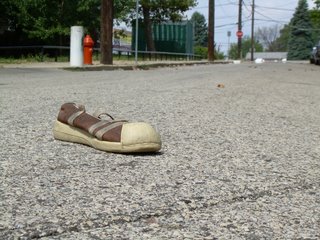 We wandered in front of the public housing office. If you look at any of the photos, you’ll notice what an incredible day it was; I suck wholly a taking pictures, and these came out pretty well anyhow. I got one incredible shot of an old-school sneaker sitting in the middle of a street. I am the New Chronicler of Urban America, yes I am.
We wandered in front of the public housing office. If you look at any of the photos, you’ll notice what an incredible day it was; I suck wholly a taking pictures, and these came out pretty well anyhow. I got one incredible shot of an old-school sneaker sitting in the middle of a street. I am the New Chronicler of Urban America, yes I am.
What I didn’t photograph was the drug deal we saw immediately there after. Jittery looking guy sits in front of the public housing office; second guy, with a goatee, wanders up the path, accepts a bill from Jittery Guy, gives him a tiny packet of something, walks away. It all was as quiet as communion, and took about 3 seconds. I know that never having witnessed a drug deal in my three years in Philly makes me distinctly un-edgy. I was just stunned at the open-air quality of it all – it was like, “shouldn’t this be transacted through a mail slot in a basement somewhere?”
Obviously, I can skip the morality play about the destructive, interlocking cycles of addiction, poverty, and crime; it’s boring, and surely some sociologist at Penn has a better lecture on it than I do. Even so, and as naïve and lame as it sounds, this trip will get written in my memory as the first place I saw someone buy drugs on the street. The inevitable implication – that this whole Philly Field Trips project smacks a little bit of white-guy adventurism (Public housing! Black Muslims! Drugs!) – is something I’ll probably have to just live with.
Some photos of plants and stuff: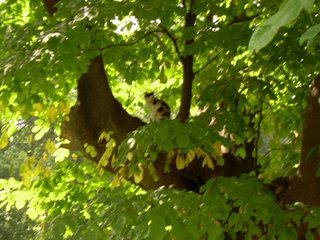
Found a slightly mangy cat up in a tree in Bartram's Garden. Seems like a good place to do cat things.

Some fine-ass nature photography, if I do say so myself. Except - can someone identify this plant for me? Thank you.

This, of course, is the much-bemoaned pile of trash on the banks of the Schuykill. See what you've done, Philadelphia!

The Bartram House from a distance. Nice digs, eh?
Monday, September 18, 2006
(taps chest) My Bad

Work has been unbelievably insane the last couple of weeks, blah blah blah. New post will be up tomorrow, and regular posting will resume (commence?) thereafter. Cheerio.
Friday, August 18, 2006
Bridesburg

My trip to Bridesburg began with the unfortunate realization that the SEPTA subway revolving doors – the ones with the big, interlocking metal bars – aren’t meant for people and bikes. To successfully navigate through the passage, I had to flip the bike up on one end and shuffle my feet until I was clear of the door – it probably looked a little like I was making an awkward attempt to mate with the bike.
I hopped onto Orthodox Street and pedaled through an African-American neighborhood in Kensington. Orthodox is one of only four ways in or out of Bridesburg; Route 95, the Betsy Ross Bridge, and the Delaware pretty much cordon off the neighborhood from the rest of the city, meaning that it doesn’t get a ton of through traffic. This, I suspect, is all well and good with most of the locals.
Bridesburg was more or less a name picked out of a hat as the first field trip for the site. I ran across the name sorting through the list of Philly neighborhoods, and recognized it as the “thank God, we’re almost home” stop on the SEPTA line from Trenton and New York. It’s relatively crime-free, relatively small, and has a distinct, traceable history.
I am totally indebted to Tony J., who runs the bridesburg.net website, for almost everything I know about the ‘burg. I won’t get too deeply into the history of the place; some really awesome historical work has been done here and here. For most of the century, it’s been a heavily Polish (with some Irish and German sprinkled in) working community with strong historical ties to the river and to the industry that’s dotted the riverbanks since the early 19th century. Tony was nice enough to play tour guide for about half of the trip, and told me about his summers working at the Rohm & Haas plant off of Bridge Street. When the plant was operating at full capacity earlier in the 20th Century, it employed over 3,200 people; by the time Tony worked there a couple decades ago, numbers had dwindled into the 700s.
 One of the first things that strikes your eye when you get through the I-95 underpass into Bridesburg: American flags everywhere. In Center City, you’d have to poke around for a while to find one block with a flag on display; I counted over 100 on one randomly selected block of Bridesburg alone.
One of the first things that strikes your eye when you get through the I-95 underpass into Bridesburg: American flags everywhere. In Center City, you’d have to poke around for a while to find one block with a flag on display; I counted over 100 on one randomly selected block of Bridesburg alone.
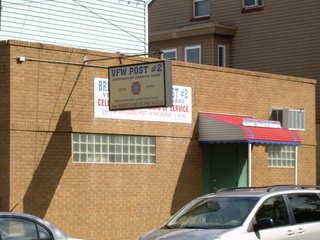 Signs of military affiliation are ubiquitous, and the neighborhood is home to the second oldest VFW post in America. The VFW was founded in 1899, after the Spanish American War, and you can imagine that the sons of the neighborhood headed out to every major conflict of the last 100 years. Obviously, a sense of community has built around this fact, and you see yellow-ribbon “SUPPORT OUR TROOPS – COME HOME SAFE” on so many houses. To risk stating the obvious: wars are different when it’s personal rather than just political.
Signs of military affiliation are ubiquitous, and the neighborhood is home to the second oldest VFW post in America. The VFW was founded in 1899, after the Spanish American War, and you can imagine that the sons of the neighborhood headed out to every major conflict of the last 100 years. Obviously, a sense of community has built around this fact, and you see yellow-ribbon “SUPPORT OUR TROOPS – COME HOME SAFE” on so many houses. To risk stating the obvious: wars are different when it’s personal rather than just political.
We jumped in Tony's minivan and headed over to the Harmonia Club, one of the clubs that has functioned as a social hub for Bridesburg for decades. Apparently, membership in these clubs - the Polonia and the Point-No Point Clubs are two others - had been on the wane in years past, but there's been a movement to revitalize them for a newer generation. The activities at the Harmonia Club have diversified; they serve great crabs for dinner many nights of the week, and a bowling league starts up in the winter.
Tony had to head out, and was nice enough to drop me back at my chained-up bike. I rode around the neighborhood a little bit longer - I tried to get a good shot of the Betsy Ross Bridge, but public waterfront access in Bridesburg really isn't there, unfortunately. In a community with such heavy ties to the river, it's really a shame that you have to leave the neighborhood to get to it.
I commented to Tony that for the most part, the neighborhood has about 90% of everything you'd  really need - bars, a few places for food, hardware, produce, drug stores, schools, a travel agency (specializing in trips to - where else - Poland), and more bars. Tony then told me that a number of places had moved out of Bridesburg in the last few years; in particular, a lot of bars have closed down since he was younger. Now, Bridesburg has about 30 blocks, and at least 7 or 8 places to have a drink - my hometown of 40,000 people has about 3. Another pertinent fact: the price of my pint of Yuengling at Ozzie's Tavern was $1.60. Well done, Bridesburg.
really need - bars, a few places for food, hardware, produce, drug stores, schools, a travel agency (specializing in trips to - where else - Poland), and more bars. Tony then told me that a number of places had moved out of Bridesburg in the last few years; in particular, a lot of bars have closed down since he was younger. Now, Bridesburg has about 30 blocks, and at least 7 or 8 places to have a drink - my hometown of 40,000 people has about 3. Another pertinent fact: the price of my pint of Yuengling at Ozzie's Tavern was $1.60. Well done, Bridesburg.
Walking around, things are busy and quiet at the same time, if that makes any sense. Apparently, after a few years of decline, people are moving back into the neighborhood; new houses are being built, and prices, like everywhere else in Philly, are headed through the roof. Bridesburg has a bit of a bad rap for being an entirely lily-white neighborhood, and while it's pretty homogenous, I did see more black and Hispanic families than I was expecting to. With the construction of over a thousand homes down by the river on the horizon, the neighborhood's set to continue expanding in the near future. It'll be interesting to see how Bridesburg evolves when it takes in a couple thousand newcomers.
More pictures:
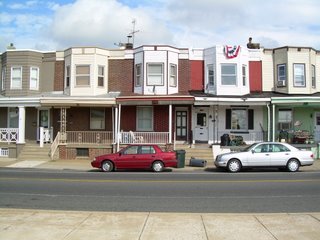 Row houses near the Betsy Ross Bridge on-ramp.
Row houses near the Betsy Ross Bridge on-ramp. The baseball field for the Cougars, a popular local sports club.
The baseball field for the Cougars, a popular local sports club. The elaborate gatehouse to Holy Redeemer Cemetery, the largest graveyard in the neighborhood. Really cool building.
The elaborate gatehouse to Holy Redeemer Cemetery, the largest graveyard in the neighborhood. Really cool building. Renzi's Pizzeria, where I had the finest cheesesteak hoagie to ever give me a severe case of heartburn.
Renzi's Pizzeria, where I had the finest cheesesteak hoagie to ever give me a severe case of heartburn.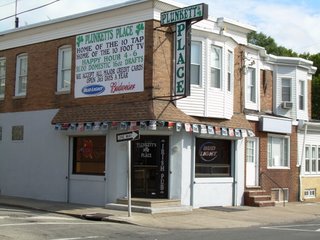 Plunkett's Place, home of the 10-foot TV. Open 365 days a year. I know where I'm spending Christmas.
Plunkett's Place, home of the 10-foot TV. Open 365 days a year. I know where I'm spending Christmas.Tuesday, August 08, 2006
Hey There
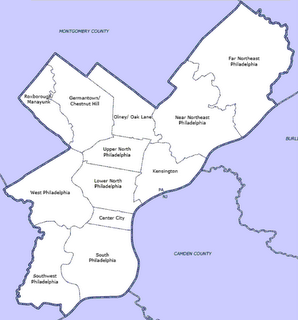
A demographic map of Philly’s neighborhoods would probably look a little like a checkerboard drawn by a drunk. Old folks, young folks, white people, black people, Asians, Hispanics, Irish, Italians, gays, straights – it’s not precisely a melting pot; it’s more like a paper bag into which the city’s ingredients have been dumped and shaken up.
On trips into the city with my grandparents when I a kid, I remember being amazed at the way that the look and feel of an area could change drastically in the space of a few blocks. My overall sense of urban history is a little sketchy, so I can’t attest to why this is – surely immigration and migration patterns, segregated housing practices, and the constant, lurching roller coaster of the housing market account for most of it.
There are over 100 named neighborhood in Philadelphia, say our ever-to-be-taken-with-a-grain-of-salt friends at Wikipedia. The goal of Philly Field Trips is to go to as many of those neighborhoods as possible; to have a look around, hopefully talk to some residents, maybe snap some decidedly non-professional photos. Your narrator is not a journalist, nor a Philly native – instead, you’ve got an overeducated, perpetually awkward twentysomething who’s lived in the city for a mere three years, and has undertaken this project primarily for his own amusement. Well, sorry. We all have to make do somehow.
I’ll try to update this on more or less a weekly basis; generally speaking, I should have a new post up every Tuesday night. Where possible, I’ll try to link to as much information as possible about each neighborhood. Two websites in particular are always handy: a similar project is ongoing at phillyskyline.com, albeit with a little less narrative and way better pictures than I’ll be able to take; and the forums at phillyblog.com, where various Philadelphians discuss, update, quibble, and argue about the changes taking place in their necks of the woods.